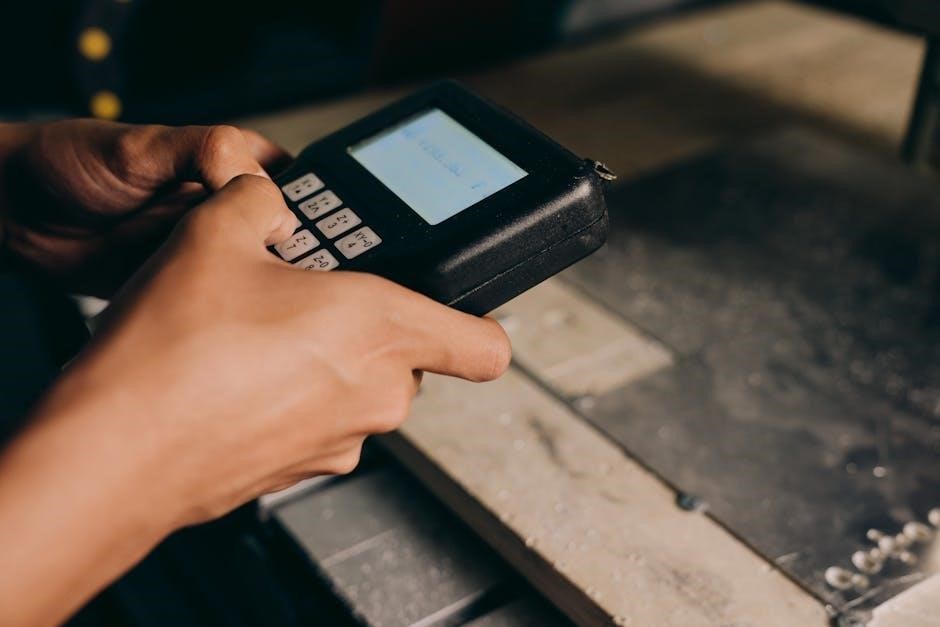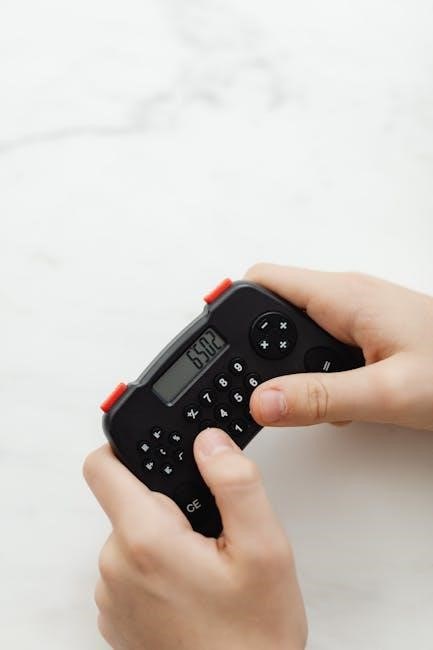
honeywell 6150 keypad user manual pdf
This manual provides a comprehensive guide for the Honeywell 6150 keypad, offering detailed instructions for installation, programming, and troubleshooting; Designed for both new and experienced users, it ensures optimal functionality of the security system, covering essential features and operations.
1.1 Overview of the Honeywell 6150 Keypad
The Honeywell 6150 keypad is a fixed, English-display keypad designed for use with Honeywell security systems. It features a three-digit numeric display for zone identification and English-language prompts for system status. The keypad has a sleek, white design with a contoured, removable door concealing soft-touch illuminated keys. It is compatible with various Honeywell control panels, including VISTA series models, and supports wireless capabilities through the 6150RF transceiver. This keypad is easy to install and user-friendly, making it ideal for both residential and commercial security setups. Its intuitive interface and customizable function keys allow for tailored security solutions, ensuring efficient monitoring and control of the system.
1.2 Importance of the User Manual for Proper Usage
The Honeywell 6150 keypad user manual is essential for maximizing the functionality and security of your system. It provides step-by-step guides for installation, programming, and troubleshooting, ensuring users can operate the keypad effectively. The manual covers critical tasks such as setting user codes, configuring function keys, and understanding system status messages. Without the manual, users may struggle with basic operations or miss advanced features, potentially compromising security. Additionally, the manual offers solutions for common issues, helping users resolve problems quickly and maintain system integrity. Regular reference to the manual ensures optimal performance and user confidence in managing their security setup.

Key Features of the Honeywell 6150 Keypad

The Honeywell 6150 keypad features a numeric display for zone identification, programmable function keys, and English-language prompts for system status. It combines ease of use with advanced security capabilities.
2.1 Numeric Display for Zone Identification
The Honeywell 6150 keypad is equipped with a numeric display that simplifies zone identification, ensuring users can quickly recognize which security zones are active or in alarm. This feature enhances system clarity, especially in larger installations with multiple zones. The display provides real-time updates, allowing users to monitor the status of their security system effortlessly. Its bright, easy-to-read interface ensures visibility even in low-light conditions. This functionality is particularly useful for troubleshooting, as it provides clear indicators for zone-related issues. By displaying zone numbers and statuses, the keypad offers an intuitive way to manage and respond to security events. This feature is a cornerstone of the keypad’s user-friendly design.
2.2 Programmable Function Keys
The Honeywell 6150 keypad features programmable function keys, allowing users to customize their security experience. These keys can be tailored to perform specific actions, such as arming or disarming select zones, triggering panic alerts, or activating custom scenarios. By assigning functions to these keys, users can streamline their security management, reducing the need for complex menu navigation. This feature is particularly useful for users who prefer a personalized and efficient interaction with their security system. The programmable keys enhance accessibility and ensure that frequently used functions are readily available. This level of customization makes the Honeywell 6150 keypad adaptable to various security needs, providing a seamless and user-friendly experience. Proper programming ensures optimal functionality and convenience.
2.3 English-Language Prompts for System Status
The Honeywell 6150 keypad incorporates English-language prompts to provide clear and intuitive system status updates. These voice or text-based notifications guide users through operations, such as arming, disarming, or troubleshooting. The prompts ensure that users are well-informed about the system’s current state, reducing confusion and enhancing overall user experience. This feature is particularly beneficial for individuals who may not be familiar with complex security systems. By offering real-time feedback, the keypad helps users make informed decisions quickly. The English-language prompts also simplify troubleshooting by clearly indicating issues like zone violations or system errors. This feature ensures that users can interact with the keypad confidently, knowing they receive accurate and understandable information. It’s a key aspect of the keypad’s user-friendly design, making it accessible to a wide range of users. Proper understanding of these prompts is essential for effective system management.
2.4 Wireless Capabilities with 6150RF Keypad/Transceiver
The Honeywell 6150 keypad can be paired with the 6150RF keypad/transceiver for enhanced wireless functionality. This combination allows seamless integration with wireless sensors and devices, expanding the system’s flexibility. The 6150RF transceiver supports up to 40 wireless zones, ensuring comprehensive security coverage. It operates on a reliable 2.4 GHz frequency, minimizing interference and ensuring stable communication. With this setup, users can install sensors in areas where wiring is impractical, simplifying system expansion. The keypad’s wireless capabilities also enable remote arming and disarming, offering convenience without compromising security. This feature is particularly useful for large properties or systems requiring scalable solutions. The integration of wireless technology enhances the overall efficiency and adaptability of the Honeywell 6150 keypad, making it a versatile choice for modern security needs. Proper configuration ensures optimal performance and reliability. Regular updates and maintenance are recommended to sustain wireless functionality. Always refer to the user manual for detailed setup instructions.

Installation and Setup of the Honeywell 6150 Keypad
Install the keypad by connecting it to a compatible Honeywell control panel, ensuring proper mounting and wiring for seamless functionality. Follow manual guidelines for configuration.
3.1 Compatibility with Honeywell Control Panels
The Honeywell 6150 Keypad is designed to work seamlessly with Honeywell’s VISTA series control panels, including the Vista-20P, Vista-15P, and Vista-10P models. Compatibility ensures proper communication and integration, allowing users to access advanced features and maintain system reliability. Before installation, verify that the keypad is compatible with your specific control panel to avoid connectivity issues. Always refer to the user manual or manufacturer’s specifications for detailed compatibility information. Proper integration guarantees optimal performance and full functionality of the keypad’s features, such as zone control and system programming. Ensuring compatibility is crucial for a smooth setup and reliable operation of your security system.
3.2 Step-by-Step Installation Guide
Begin by turning off the system’s power to avoid accidental triggering of alarms. Mount the Honeywell 6150 Keypad in an accessible location, ensuring proper visibility and reach. Connect the keypad to the control panel using the provided wiring harness, following the wiring diagram in the manual. Secure all connections tightly to prevent loose wires. Power on the system and test the keypad’s functionality by entering your user code. If the keypad does not respond, check all connections and ensure the system is properly configured. Once verified, enroll the keypad into the system using the control panel’s programming menu. Finally, test all features to confirm proper operation. Always refer to the manual for specific wiring and configuration details.

Programming the Honeywell 6150 Keypad
The keypad allows easy programming of user codes and function keys. Use the master code to add or modify user codes. Customize function keys for specific tasks. Refer to the manual for detailed steps. Ensure all changes are saved properly to maintain system functionality. Programming is straightforward, making it accessible for both homeowners and installers.
4;1 Setting Up User Codes
Setting up user codes on the Honeywell 6150 Keypad is essential for secure and personalized access. Enter the master code to access the programming menu. Create unique 4-6 digit codes for each user, ensuring they are easy to remember but difficult to guess. Assign codes to specific users or roles for better system management. Use the keypad’s navigation to scroll through options and save changes. Ensure all users are trained to use their codes responsibly. Regularly update or delete codes for former users to maintain security. The system allows up to 32 user codes, providing flexibility for homes or businesses. Always test codes after programming to confirm functionality.
4.2 Configuring Function Keys for Customized Use
Configuring function keys on the Honeywell 6150 Keypad allows for personalized system control. Access the programming menu by entering the master code. Assign specific functions to each key, such as arming/disarming, zone bypass, or panic alerts. Use the keypad’s interface to map actions to keys, enhancing user convenience. Label keys for clarity, ensuring easy identification of their functions. Test configured keys to verify proper operation. Regularly review and update key assignments as security needs evolve. This feature streamlines system interaction, making it more intuitive for users. Proper configuration ensures efficient and tailored security management, maximizing the keypad’s functionality.

Using the Honeywell 6150 Keypad
Arm, disarm, and bypass zones with ease. Check system status, handle alerts, and perform routine operations efficiently. User-friendly interface enhances security management.
5.1 Arming and Disarming the Security System
To arm the system, enter your user code and select the desired arming mode (e.g., “Away” or “Stay”). The keypad will confirm arming with a beep and status message.
Disarming requires re-entering your user code, which silences alarms and deactivates the system. Ensure all zones are secure before arming to avoid false alarms.
Use the numeric display to verify arming status. If zones are bypassed, the system alerts you during arming. Always check the keypad’s English-language prompts for confirmation.
Key points: Arm only when all protected areas are secure, use the correct code for disarming, and address any bypassed zones promptly for optimal security.
5.2 Bypassing Zones for Temporary Security Changes
To bypass zones on the Honeywell 6150 keypad, enter your user code and select the zone(s) you wish to bypass. The keypad will display the zone number and confirm the bypass with an English-language prompt.
Bypassing is ideal for temporary changes, such as allowing movement in specific areas without triggering alarms. Once bypassed, the system ignores activity in those zones until reinstated.
Remember to unbypass zones after the temporary change to restore full system protection. Use this feature sparingly to maintain security integrity. Key points: Always confirm bypassed zones, ensure zones are secure before reactivating, and avoid bypassing critical areas unnecessarily.
5.3 Understanding System Status Messages
The Honeywell 6150 keypad provides clear English-language status messages to inform users about the system’s current state. Messages like “Ready to Arm,” “System Armed,” or “Zone Bypassed” help users understand the security setup.
The keypad also displays alerts for system errors, such as “Zone Fault” or “Low Battery,” ensuring users can address issues promptly.
Color-coded LEDs further assist in understanding the system status: green for ready, red for armed, and yellow for faults. Familiarizing yourself with these messages ensures proper system operation and quick resolution of issues. Always refer to the manual for detailed explanations of specific codes and their solutions.

Troubleshooting Common Issues
Troubleshooting the Honeywell 6150 keypad involves addressing common issues like keypad freezes, error codes, or sensor malfunctions. The manual provides step-by-step solutions to resolve these problems efficiently.
6.1 Resolving Keypad Panic Issues
The Honeywell 6150 keypad may experience panic issues, such as accidental activation or non-response. To resolve this, ensure the panic key is functioning correctly and configured properly in the system settings. If the panic key is triggered accidentally, disconnect power to the keypad, wait 30 seconds, and reconnect. This resets the keypad. If the issue persists, check for loose wiring or damaged components. Verify that the panic function is enabled in the control panel programming. Test the panic feature after addressing these areas. For recurring problems, consult the user manual or contact Honeywell support for further assistance. Regular maintenance and updates can prevent such issues from arising.
6.2 Clearing Alarm Codes and System Errors
To clear alarm codes and system errors on the Honeywell 6150 keypad, start by entering your master code to access the system menu. Navigate to the “Alarm Codes” or “System Errors” section using the arrow keys. Highlight the specific error code you wish to clear and press the “Clear” or “OK” button. Confirm the action if prompted. Once cleared, exit the menu and test the system to ensure the issue is resolved. If errors persist, check for underlying causes such as faulty sensors or wiring issues. Regularly reviewing and clearing alarm codes helps maintain system efficiency. Always refer to the user manual for detailed instructions tailored to your system configuration.
6;3 Resetting the Keypad to Factory Settings
Resetting the Honeywell 6150 keypad to factory settings is a straightforward process that restores it to its default configuration. To do this, press and hold the “1” and “9” keys simultaneously for 5 seconds until the keypad beeps. Release the keys and enter the installer code (default is 4111). Navigate to the “System” menu and select “Factory Reset.” Confirm the action by pressing “OK.” The keypad will reboot, erasing all custom settings, user codes, and zone configurations. After the reset, reprogram the keypad according to your security needs. Note that this process cannot be undone, so ensure all necessary data is backed up before proceeding. Always consult the user manual for detailed instructions specific to your system.

Advanced Features of the Honeywell 6150 Keypad
The Honeywell 6150 keypad offers advanced features such as wireless sensor integration and customizable alerts, enhancing system flexibility and responsiveness to various security scenarios.
7.1 Using the Keypad with Wireless Sensors
The Honeywell 6150 keypad seamlessly integrates with wireless sensors, enhancing security systems by providing real-time monitoring and alerts. Wireless sensors, such as motion detectors or door contacts, communicate with the keypad via radio frequencies, eliminating the need for cumbersome wiring. These sensors can be placed strategically around a property to detect specific events like unauthorized entry or motion in restricted areas. The keypad can display which sensor triggered an alert, allowing users to quickly identify potential threats. Compatibility is crucial, so ensure that sensors are designed for the Honeywell 6150 system. The keypad supports multiple sensors, each monitoring different zones, and can be programmed to respond appropriately to each trigger. Battery life for wireless sensors is typically long, but regular checks are recommended to maintain reliability. Troubleshooting connectivity issues is straightforward, with the keypad often providing error messages or indicators to help resolve problems. By integrating wireless sensors, users can create a comprehensive and flexible security system tailored to their needs, ensuring enhanced protection and peace of mind.
7.2 Customizable Alerts and Notifications
The Honeywell 6150 keypad offers customizable alerts and notifications, allowing users to tailor system responses to their specific needs. Alerts can be programmed for various events, such as arming/disarming the system, zone breaches, or low battery warnings. Users can assign unique tones or messages to differentiate between types of alerts, ensuring quick identification of system status changes. The keypad also supports visual notifications, with LED indicators providing additional feedback. Customizable alerts enhance security by keeping users informed of system activities in real-time. By personalizing these settings, users can streamline their security management and respond promptly to potential threats. This feature is particularly useful for large systems with multiple zones or sensors, ensuring clarity and efficiency in monitoring and addressing security events. Regularly reviewing and updating these settings is recommended to maintain optimal system performance.

Compatibility and Integration
The Honeywell 6150 keypad seamlessly integrates with Honeywell security systems, ensuring compatibility with various control panels and devices for enhanced functionality and system coordination.
8.1 Supported Control Panels for the 6150 Keypad
The Honeywell 6150 keypad is designed to work seamlessly with a range of Honeywell control panels, including the VISTA-20P, VISTA-15P, and VISTA-128B systems. These panels provide advanced security features and support both wired and wireless configurations. Compatibility ensures reliable communication between the keypad and the control panel, enabling smooth operation of the security system. The keypad can be used as a primary or secondary interface, offering flexibility for system setup and monitoring. For specific compatibility details, users should refer to the Honeywell 6150 keypad user manual, which outlines supported panels and any necessary configuration steps. Proper pairing ensures optimal performance and integrates seamlessly with the system’s functionality.
8.2 Integration with Other Honeywell Security Devices
The Honeywell 6150 keypad seamlessly integrates with a variety of Honeywell security devices, enhancing system functionality and user experience. It works in conjunction with wireless sensors, motion detectors, and security cameras, creating a comprehensive security network. The keypad also supports integration with Honeywell’s Total Connect 2.0 remote monitoring platform, enabling users to control and monitor their systems remotely. Additionally, it can be paired with smart home devices, such as door locks and thermostats, for enhanced automation. This integration ensures that the keypad serves as a central hub for managing all security and smart home features. Proper setup and configuration are essential for optimal performance, as outlined in the user manual.

Maintenance and Upkeep
Regularly clean the keypad and ensure proper power supply. Check for firmware updates and perform system diagnostics to ensure optimal functionality and longevity of the device.
9.1 Cleaning the Keypad for Optimal Performance
To maintain the Honeywell 6150 keypad’s functionality, clean it regularly. Power off the device and use a soft, dry cloth to wipe the surface. For stubborn dirt, slightly dampen the cloth with water, avoiding harsh chemicals. Use compressed air to gently remove dust from between keys. Avoid spraying liquids directly onto the keypad to prevent damage. After cleaning, let it dry completely before turning it on. Regular cleaning prevents grime buildup and ensures responsive buttons. For the display, if present, use a screen cleaning wipe. Test the keypad post-cleaning to ensure all functions work properly; Follow these steps to keep your Honeywell 6150 keypad performing optimally and reliably.
9.2 Updating Software and Firmware
Regularly updating the Honeywell 6150 keypad’s software and firmware ensures optimal performance and security. Start by checking Honeywell’s official website for the latest updates. Download the firmware file and transfer it to the keypad using a compatible interface or USB connection. Access the keypad’s update menu, typically found in the system settings, and follow the on-screen instructions to initiate the update. Ensure the keypad remains powered on and connected to the control panel during the process. Avoid interrupting the update, as this may cause system instability. Once complete, restart the keypad and verify the update was successful. For assistance, refer to Honeywell’s support documentation or contact their customer service team. Always use authorized updates to maintain system integrity and functionality.
The Honeywell 6150 keypad manual provides essential guidance for installation, usage, and troubleshooting. It ensures users maximize their security system’s functionality and reliability.
10.1 Summary of Key Points
The Honeywell 6150 keypad user manual provides a comprehensive guide for installing, programming, and operating the device. It covers key features like the numeric display, programmable function keys, and wireless capabilities. The manual also details steps for arming/disarming the system, bypassing zones, and troubleshooting common issues. Additionally, it highlights advanced features such as integration with wireless sensors and customizable alerts. Maintenance tips, including cleaning and software updates, are also included to ensure optimal performance. By following the manual, users can maximize the functionality and reliability of their security system.
Whether you’re a new or experienced user, this guide ensures seamless operation and customization of the Honeywell 6150 keypad, enhancing your overall security experience.
10.2 Final Tips for Effective Use of the Honeywell 6150 Keypad
To maximize the performance of the Honeywell 6150 keypad, ensure regular maintenance and updates. Clean the keypad periodically to prevent dust buildup and maintain responsiveness. Familiarize yourself with all programmable function keys to tailor the system to your needs. Always refer to the user manual for guidance on advanced features or troubleshooting. Keep backup power sources handy to avoid interruptions during outages. Test your system periodically to ensure all zones and sensors are functioning correctly. Lastly, stay informed about software updates to benefit from the latest enhancements and security improvements. By following these tips, you can enjoy a seamless and secure experience with your Honeywell 6150 keypad.